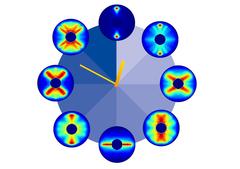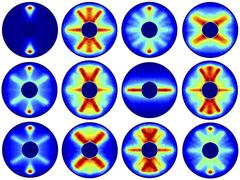URL: https://www.desy.de/news/news_search/index_eng.html
Breadcrumb Navigation
DESY News: Scientists film molecular rotation
News
News from the DESY research centre
Scientists film molecular rotation
Scientists have used precisely tuned pulses of laser light to film the ultrafast rotation of a molecule. The resulting “molecular movie” tracks one and a half revolutions of carbonyl sulphide (OCS) – a rod-shaped molecule consisting of one oxygen, one carbon and one sulphur atom – taking place within 125 trillionths of a second, at a high temporal and spatial resolution. The team headed by DESY’s Jochen Küpper from the Center for Free-Electron Laser Science (CFEL) and Arnaud Rouzée from the Max Born Institute in Berlin are presenting their findings in the journal Nature Communications. CFEL is a cooperation of DESY, the Max Planck Society and Universität Hamburg.

The different stages of the molecule's periodic rotation repeat after about 82 picoseconds. Credit: DESY, Evangelos Karamatskos/Britta Liebaug
Altogether, the scientists took 651 pictures covering one and a half periods of rotation of the molecule. Assembled sequentially, the pictures produced a 125 picosecond film of the molecule’s rotation. The carbonyl sulphide molecule takes about 82 trillionths of a second, i.e. 0.000 000 000 082 seconds, to complete one whole revolution. “It would be wrong to think of its motion as being like that of a rotating stick, though,” says Küpper. “The processes we are observing here are governed by quantum mechanics. On this scale, very small objects like atoms and molecules behave differently from the everyday objects in our surroundings. The position and momentum of a molecule cannot be determined simultaneously with the highest precision; you can only define a certain probability of finding the molecule in a specific place at a particular point in time.”

Steps of the molecule's rotation, recorded with an average gap of seven picoseconds each. Credit: DESY, Evangelos Karamatskos
The scientists believe that their method can also be used for other molecules and processes, for example to study the internal twisting, i.e., torsion, of molecules or chiral compounds, that are compounds that exist in two forms, which are mirror images of each other – much like the right and left hands of a human being. “We recorded a high-resolution molecular movie of the ultrafast rotation of carbonyl sulphide as a pilot project,” says Karamatskos, summarising the experiment. “The level of detail we were able to achieve indicates that our method could be used to produce instructive films about the dynamics of other processes and molecules.”
In addition to DESY, Universität Hamburg, the Max Born Institute in Berlin, and the University of Aarhus in Denmark were also involved in the project.
Reference:
Molecular movie of ultrafast coherent rotational dynamics; Evangelos T. Karamatskos, Sebastian Raabe, Terry Mullins, Andrea Trabattoni, Philipp Stammer, Gildas Goldsztejn, Rasmus R. Johansen, Karol Długołęcki, Henrik Stapelfeldt, Marc J. J. Vrakking, Sebastian Trippel, Arnaud Rouzée, and Jochen Küpper; Nature Communications, 2019; DOI: 10.1038/s41467-019-11122-y



